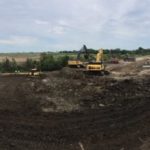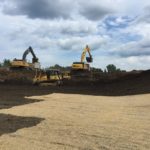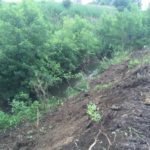- Company: A.W. Oakes & Son, Inc.
- Industry: Water/Wastewater
- Location: Mount Pleasant, Wisconsin
- Expected Completion Date: November 13, 2015
- Project Website
The Village of Mount Pleasant has had problems for years with the Pike River, a small river more like a canal in places, backing up during heavy rainfalls and snow melt in the spring and flooding homes along the river. Over the past 10 years, with the help of funding from the DNR and federal government, they have been reconstructing and widening out sections of it every year or every other year. This past year we completed the last phase for Mount Pleasant, which was approximately a 1/2 mile of the river. The project consisted of clearing and grubbing, hauling approximately 225,000 CY’s of soil to another property down the road a couple miles from the site, constructing fore bays and channels outside the main river bed, and installing e-mat, log dams, and other erosion control measures. The new river construction will prevent flooding during large rain events and snow melt and provide much better conditions for fish that come up the river to spawn. Erosion and sediment run-off will be controlled much better as well.
What impact does this project have on America?
This project has significantly improved the river through this area and helped the residents along the river not have to worry about their homes flooding. It has also greatly improved the ecosystem along the river. There are walking paths that have been installed along portions of the river. The local high school biology students are able to walk right out by a portion of the river and do science experiments. The habitat for fish and other animals that was nearly non-existent before is now thriving.
This river also eventually drains to lake Michigan so cleaning it up and minimizing contaminants flowing in to it and to the Lake is a win for everyone!
What interesting obstacles or unusual circumstances did you overcome to complete the project?
The most challenging part of the project was that all the excavated soils had to be trucked down a stretch of busy urban highway to a fill site. Frequently a project like this would have utilized all off road trucks or scrapers and had a fill site nearby. That was not practical here so we had to haul with on road dump trucks. There were approximately 18,000 dump truck loads hauled off the site. A lot of traffic coordination was required and a full time street sweeper!
Maintaining the existing river flow during construction was also a challenge. A number of temporary large culvert crossings had to be installed to cross the river and access dirt on opposite sides of the river from where our exit points were. During large rain events we were flooded out and shut down for a while and a lot of pumping was performed in order to get back to work. At the same time care had to be taken to not disturb fish that were in the river and prevent sediment run-off.
Keeping up with erosion control before rain was always a task, so we had our landscaping guys on site every afternoon and in to the evening to get erosion matting on everything that was topsoilled that day. There were also thousand of small wood posts that had to be pounded in along the main rivers edge to support erosion control measures. We utilized a retrofitted pneumatic hammer to pound them in. Our guys really liked that over the good old hammer on the hot summer days!
What dangers and risks did you encounter, and describe any extraordinary methods used to keep workers safe?
The biggest safety factor was all the truck traffic. There were on average 50-60 truck loads per hour going out between the two back hoes that were loading dirt out. Every morning there were pre-job meetings discussing the haul routes and reiterating that safety was more important than getting that one more load per day. Safety on the busy roadway we had to haul out on to was important as well. A number of days heat exhaustion amongst the laborers placing e-mat was a concern as it was extremely hot and up and down the embankment is not easy work, so getting plenty of water and keeping an eye on each other was discussed frequently.
How did you leverage new technologies to work faster and reduce waste?
We utilize GPS grade control a lot on all of our projects, but utilizing GPS on the two main dozers really helped with quality and efficiency of the excavation. The labor time saved versus staking the entire project probably could purchase a GPS unit on a project like this one. Utilizing Heavybid to bid and get the project and HeavyJob to manage the progress of this project as well as many other projects to become more efficient has been priceless!










